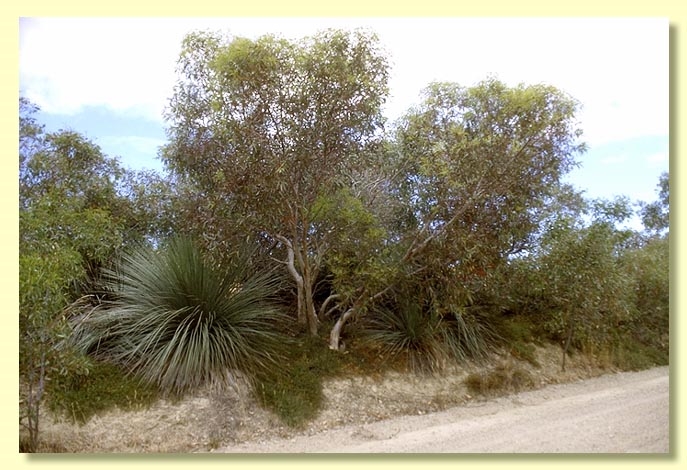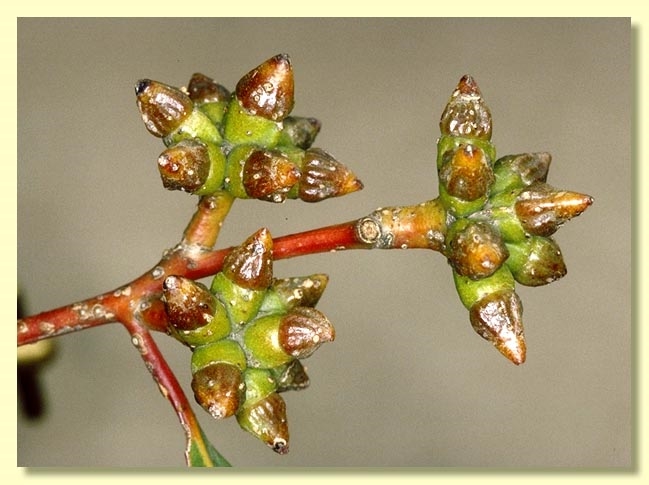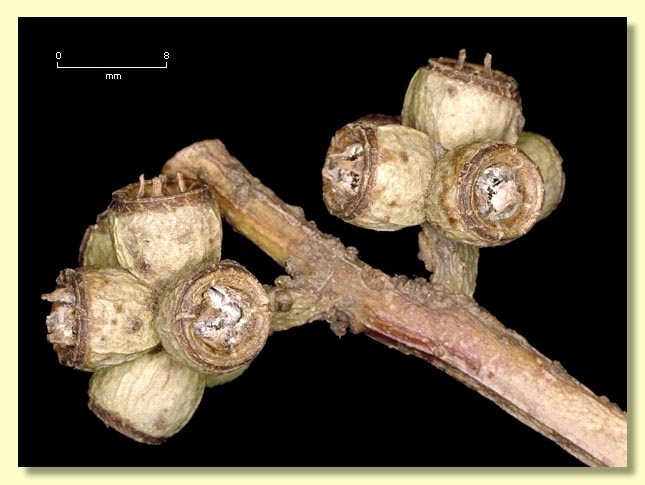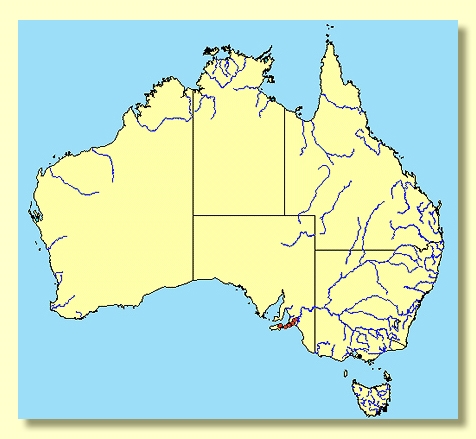Euclid - Online edition
Eucalyptus phenax subsp. compressa
Eucalyptus | Symphyomyrtus | Dumaria | Rufispermae
Bark smooth, creamy-grey to brown, decorticating in ribbons, sometimes accumulating at the base.
Branchlets have oil glands in the pith.
Juvenile growth (coppice or field seedlings to 50 cm): stem rounded in cross-section, smooth; juvenile leaves alternate, petiolate, ovate to lanceolate, 5–9 cm long, 1–2.5 cm wide, base tapering to petiole, margin entire, apex pointed, green.
Adult leaves alternate, petiole 1.5–2 cm long; blade lanceolate to falcate, 6–11 cm long, 1.5–3.5 cm wide, flat, base tapering to petiole, margin entire, apex pointed, concolorous, glossy, green, side-veins at an acute or wider angle to midrib, moderately to densely reticulate, intramarginal vein present, oil glands intersectional.
Inflorescence axillary single, peduncle 0.8–1.4 cm long, buds 7, sessile. Mature buds cylindrical to ovoid (0.7–1.3 cm long, 0.4–0.6 cm wide), usually with longitudinal ribs, operculum conical to turban-shaped (0.4–0.7 cm long), scar present, stamens inflexed, cuboid to wedge shaped versatile anthers, dehiscing by longitudinal slits (non-confluent), style long, stigma tapered or blunt, locules 3 or 4, the placentae each with 4 vertical ovule rows. Flowers white or creamy white.
Fruit, sessile, cup-shaped to cylindrical to barrel-shaped, 0.6–0.7 cm long, 0.6–1 cm wide, disc raised to level to descending, valves 3 or 4, near rim level or enclosed.
Seeds reddish brown, glossy, 1.5–2 mm long, flattened-ovoid, dorsal surface smooth or irregularly wrinkled, sometimes lacunose, hilum ventral.
Cultivated seedlings (measured at ca node 10): cotyledons reniform; stems square to rounded in cross-section; leaves always petiolate, opposite for ca 3 pairs then alternate, ovate, 4–7.5 cm long, 2–4.5 cm wide, dull, green.
Flowering time unknown.
Eucalyptus phenax is a mallee species widespread in mallee scrubs of southern Australia, from the southern part of the northern wheatbelt of Western Australia near Bolgart, east through the southern wheatbelt to the Esperance subcoastal plains, also in South Australia in the Gawler Ranges, Eyre Peninsula, Kangaroo Island, Murray Mallee and eastwards to the Little Desert and Sunset Country in north-western Victoria (but not New South Wales). The stems are smooth-barked and the adult leaves glossy green.
In the classification of Brooker (2000) Eucalyptus repullulans belongs in Eucalyptus subgenus Symphyomyrtus section Dumaria having these features: buds initially with two opercula the outer shed early, stamens strongly inflexed, ovules in 4 rows on the placentae and cotyledons reniform. Within section Dumaria the species belongs to a large sub-group of closely related species (series Rufispermae, 37 described species and subspecies) diagnosed by glandular pith in the branchlets, cuboid to wedge shaped versatile anthers, and by the reddish brown and glossy, flattish seeds which are unique to the series.
In Victoria and South Australia Eucalyptus phenax is distinguished from E. dumosa, E. cyanophylla, E.percostata and E. conglobata by its glossy green leaves; and from E. pileata and E. caklcareana by smaller buds and fruit. In Western Australia E. phenax subsp. phenax can often be difficult to distinguish from the following mallee taxa:: E. conglobata subsp. perata, E. pileata and E. arguitifolia.
E. conglobata subsp. perata has consistently sessile buds and fruit and only slightly glossy leaves, E. pileata has buds with the operculum consistently wider than the hypanthium whilst E. argutifolia, which is found only in the Wabling Hill area north of Perth, is very similar to E. phenax subsp. phenax differing only in the slightly boader adult leaves and consistently round-topped buds (not conical).
There are two subspecies:
E. phenax subsp. phenax
Differs from subsp. compressa by the narrower leaves, shorter peduncles, longer pedicels, and less crowded fruit that are longer than wide. It is the widespread mallee across southern Australia but not on Kangaroo Island.
E. phenax subsp. compressa
Contrasts with subsp. phenax especially in the sessile, crowded buds and fruit. It occurs on Kangaroo Island and southern Fleurieu Peninsula and intergrades with subsp. phenax north and east of Goolwa.
subsp. compressa: Latin compressus, compressed, referring to the fruit.












